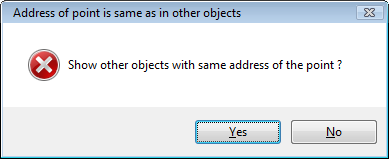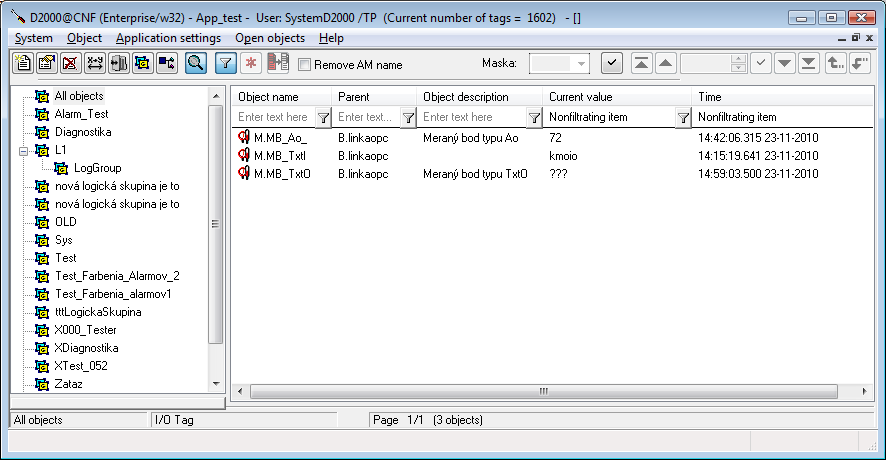...
Editing of all objects in the process D2000 CNF is being performed in the configuration dialog box, a specific part of which is common for all editable objects and another part depends on the type of edited object.
Configuration The configuration dialog box of I/O tags consists of several parts (tabs) that contain the similar parameters. Display The display of particular tabs depends on the category of particular I/O tag.
...
Defines a status text for the I/O tag. Status The status text allows to redefine redefining labels of individual I/O tag values.
...
Technological limits may be defined for I/O tags of Ai, Ao, Ci, Co, TiR, and ToR types.
| Kotva | ||||
|---|---|---|---|---|
|
...
Block Alarms
The Block Alarms check box checkbox disables the evaluation of process alarms.
Ignore Invalid
If checked, it allows to remove removing invalid values when evaluating process alarms.
Example: Value change from S1 to S2 is executed as follows: S1 --> invalid --> S2.
If the parameter is checked, the alarm evaluation will be: S1 --> S2.
If the parameter is not checked, the alarm evaluation will be: S1 --> invalid --> S2.
...
- Alarm - the column contains all possible causes of raising process alarm for the object.
- State - the radio buttons allows to select allow selecting just one of the State, Transition, or None options. Enabled State option means, that the process alarm starts when the value of the I/O tag is at least within for the period defined by the Timeout parameter, in the particular state (the name of a particular state is placed in the particular respective row, in the Alarm column - pa_ValueStateName).
- Transition - checked Transition option means , that the process alarm starts when the I/O tag value passes to a particular state (the name of a particular state is placed in the particular respective row, in the Alarm column - pa_ValueStateName).
- None - process alarm is not evaluated when this option is enabled
- ACK - checked ACK option means , that the process alarm must be acknowledged by an operator in process D2000 HI. "Transition" process alarm must be always acknowledged.
- Critical - flag of critical this process alarm will have the critical flag.
- Monitor - the option will write cause a particular change of the I/O tag value state to be written into the log database as a spontaneous value change.
- Display mask - a selection of a display mask, that will be used in process D2000 HI (the Alarm list window - the Event description column) after changing the status of one of the defined process alarms to a particular state.
Raise SIGNAL
Raise SIGNAL parameter contains three checkboxes with the following function:
- the first checkbox - is placed below the State and Transition columns. Enabling (checking) When the option is enabled (checked), the system generates the a signal, if any of the configured process alarms occursoccur.
- the second checkbox - is placed below the Critical column. Enabling (checking) the optionWhen the option is enabled (checked), the system generates the signal, if any of the configured critical process alarms occursoccur.
- the third checkbox - is placed below the Monitor column. Enabling (checking) the optionWhen the option is enabled (checked), the system will generate the signal, if any of logged the changes of defined process alarms is are written into the log database.
Generating the signal means that the system tag Signal_Trigger is set to the TRUE value.
| Kotva | ||||
|---|---|---|---|---|
|
...
It can contain the reference to a column of an object of the Structured variable type in the form ObjectName[0]^ColumnName. In such a case, the KOM process tries to copy the values of arrays with the start address which is configured in tab Address to the relevant column of the structured variable. There is no need to create individual I/O tags for each item of an array or for some other repeated address structure. Only selected communication protocols support this functionality. More additional information is mentioned in the description of a particular communication protocol.
The copying of values into the column of a structured variable is implemented only for input, the change of a particular value of a structured variable (e.g. in HI or via event) will not be transferred as output through the communication into the device.
The processing of values which that are inserted into a structured variable is limited. Following The following processing is applied:
- Conversion
- Polarity
- Filter (except for the Oscillation, Value delay, and Alignment of value time)
- Limits
All parameters which are to be processed (e.g. limit setting) are applied according to the setting of the I/O tag where the destination column is configured (i.e. "master" I/O tag). Time stamp The timestamps of the values inserted into the column of a structured variable is are identical to time stamp the timestamp of a "master" I/O tag. Value The value of the "master" I/O tag and its behavior is normal, and it is not influenced byt the configuration of the destination column.
| Kotva | ||||
|---|---|---|---|---|
|
...
Address
I/O tag address. Address The address type depends on the communication protocol of the station, that which is the parent of a particular I/O tag. Address The address is stored in the configuration database in a text form. Particular A specific communication protocol converts this address into a binary form. For internal communication protocols of the D2000 system, a protocol-dependent dialog box with the validity check of given a specified address is used during the I/O tag address configuration. For external communication protocols (OEM Protocol 1 up to OEM Protocol 16) of the D2000 system, the address is entered directly in text form.
During the saving of the I/O tag configuration, the uniqueness of its address is tested. If the address of the I/O tag is not unique (within a parent station), the system will inform about the error.
By choosing the option Yes, a new CNF dialog window opens. Only I/O tags with conflicting address addresses sharing a common parent are displayed in this window. The user can (but does not have to) change the address of these I/O tags.
Minute correction
Parameter A parameter is an integer number within the range of 0 to 59. If the time stamps of receiving values should be rounded to minutes, this value is important for rounding either up or down.
If the value is 0, it means the time correction is ignored. The time stamps timestamps of values that are limited by interval (0 - parameter) will be rounded down, i.e. to the minute in which they were received. Other time stamps Higher timestamps will be rounded up by one to the next minute.
| Kotva | ||||
|---|---|---|---|---|
|
...
Using the following group of parameters allows to define defining a filtering method of analog inputs and outputs - Ai, Ao, Ci, Co, TiR, ToR.
...
Values of I/O tags acquired from the communication, which have a new time and their values are not changed, will be represented as new values.
Limits by device
This option is available , if the device and communication protocols allow to detect detecting device limits. If the parameter is checked, then limits gained from communication with this device will be used.
None
Filtering The filtering of the I/O tag values is not enabled.
Value = New * K + Old * (1-K)
Weighed first-order filter.
- Value- value after filtering
- New - filtered value
- Old - previous value
- K - the weight of the new value - a real number from the interval (0,.0 ; .. ..1.;1,0).
The Repeat Parameter: This parameter provides compatible weighted filter behavior for change-based and server protocols (IEC-60870-5-101, IEC-60870-5-104, Modbus Server, TG809, BACnet, OPC, OPC UA ...). If a positive value of the Repeat parameter is specified, it determines the period of repeated generation of the value received by the I/O tag - similar to when the same value is repeatedly retrieved for periodically polling protocols (e.g. Modbus Client). So, if a one-time change of the I/O tag value occurs, the weighted filter will gradually progress towards the target value by repeating this value.
...

